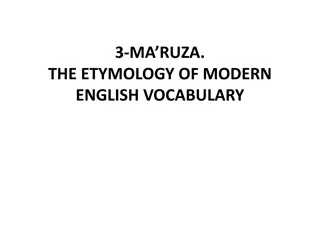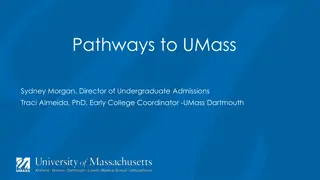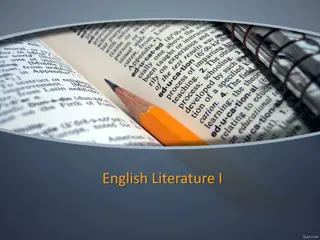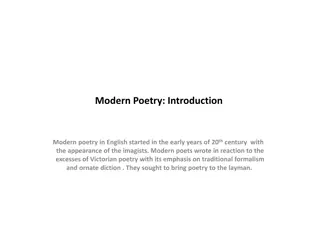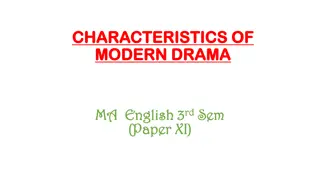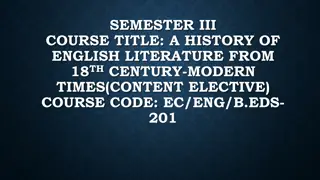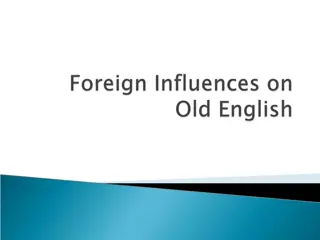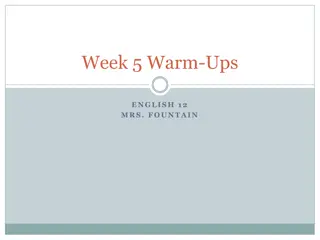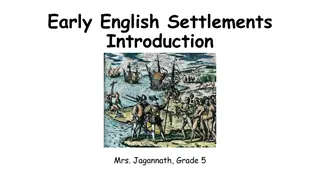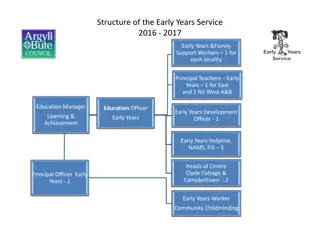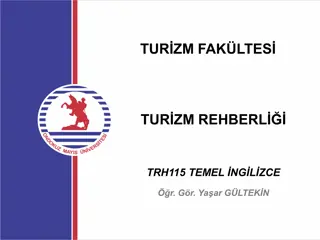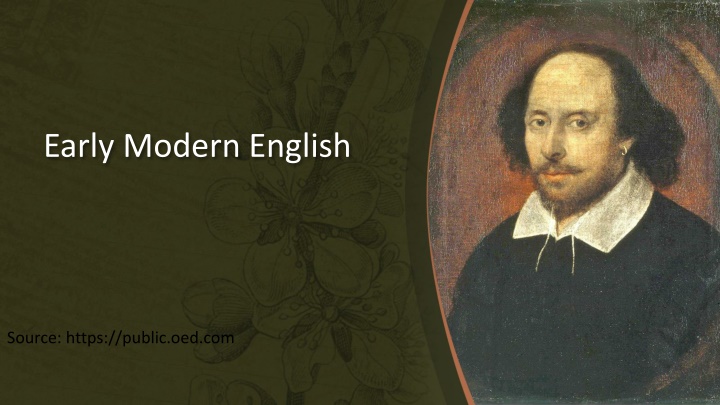
Early Modern English: Boundaries and Variations
The Early Modern English period spanned from the late 15th century to the early 18th century, characterized by significant historical events such as the Tudor and Stuart dynasties, the Reformation, and the Glorious Revolution. This era saw the evolution of English language boundaries, with variations in dialects across England and Scotland, and the emergence of London as a linguistic center. The period marked a transition towards a more standardized form of English.
Download Presentation

Please find below an Image/Link to download the presentation.
The content on the website is provided AS IS for your information and personal use only. It may not be sold, licensed, or shared on other websites without obtaining consent from the author. If you encounter any issues during the download, it is possible that the publisher has removed the file from their server.
You are allowed to download the files provided on this website for personal or commercial use, subject to the condition that they are used lawfully. All files are the property of their respective owners.
The content on the website is provided AS IS for your information and personal use only. It may not be sold, licensed, or shared on other websites without obtaining consent from the author.
E N D
Presentation Transcript
Early Modern English Source: https://public.oed.com
Boundaries of time and place The early modern English period follows the Middle English period towards the end of the fifteenth century and coincides closely with the Tudor (1485 1603) and Stuart (1603-1714) dynasties. The battle of Bosworth (1485) marked the end of the long period of civil war known as the Wars of the Roses and the establishment of the Tudor dynasty under Henry VII (1485 1509), which brought a greater degree of stable centralized government to England.
Boundaries of time and place The end of the period is marked by the religious and political settlement of the Glorious Revolution (1688), the transition to the Augustan age during the reign of Queen Anne (1702 14), and the achievement of political unity within the British Isles through the Act of Union between England and Scotland (1707).
Boundaries of time and place The defining events of the sixteenth century were those of the Reformation, initiated under Henry VIII in the 1530s, which severed both religious and political links with Catholic Europe. During the seventeenth century the new science gradually achieved prominence, beginning with the writings of Francis Bacon (1561-1626) and issuing in the foundation of the Royal Society (chartered in 1662).
Boundaries of time and place At the start of our period English was spoken throughout England except in western Cornwall, where it was rapidly replacing Cornish. The English speach doth still encroche vpon it [Cornish], and hath driuen the same into the vttermost skirts of the shire. Most of the Inhabitants can no word of Cornish; but very few are ignorant of the English. Richard Carew, The Survey of Cornwall (1602)
Variations in English During the Middle English period numerous regional dialects existed in England and Scotland. Middle English manuscripts, even copies of the same work, differ linguistically from one another to a greater or lesser degree. In the later Middle Ages London gradually emerged as the seat of administration and the court. The speech of the capital acquired social prestige and written forms of it became usual in official documents and literature, though it could only loosely be called a standard .
Variations in English Since printing was based in London this form of English was adopted by the early printers. But Caxton himself was acutely aware of variation and change within English. Certaynly our langage now vsed varyeth ferre from that which was vsed and spoken whan I was borne. William Caxton, Prologue to Eneydos (1490).
Variations in English Since printing was based in London this form of English was adopted by the early printers. But Caxton himself was acutely aware of variation and change within English. Certaynly our langage now vsed varyeth ferre from that which was vsed and spoken whan I was borne. William Caxton, Prologue to Eneydos (1490).
Variations in English Pronouncing according as one would say at London I would eat more cheese if I had it, the Northern man saith Ay suld eat mare cheese gin ay hadet, and the Westerne man saith Chud eat more cheese an chad it. Richard Verstegan, A Restitution of Decayed Intelligence (1605).
Variations in English There was a stylized stage version of western speech, as, for example, used by Edgar when posing as a countryman in King Lear. Good Gentleman goe your gate, let poore volke passe: and chud haue been zwaggar d out of my life, it would not haue bene zo long by a vortnight: nay come not neere the olde man, keepe out cheuore ye, or ile try whether your costard or my bat be the harder, chill be plaine with you. Shakespeare, King Lear, IV. vi (2nd Quarto, 1619).
Attitudes to English Early in the period, English was frequently compared unfavourably as a literary language with Latin. It was also initially seen as not possessing advantages over other European languages, as this dialogue shows. What thinke you of this English, tel me I pray you. It is a language that wyl do you good in England but passe Dover, it is woorth nothing. Is it not used then in other countreyes? No sir, with whom wyl you that they speake? With English marchants. English marchantes, when they are out of England, it liketh hem not, and they doo not speake it. John Florio, Florio his firste fruites (1578), ch. 27.
Attitudes to English The inferiority of English was often explained in terms of the mixed origin of its vocabulary. It is a language confused, bepeesed with many tongues: it taketh many words of the latine, and mo from the French, and mo from the Italian, and many mo from the Duitch, some also from the Greeke, and from the Britaine, so that if every language had his owne wordes againe, there woulde but a fewe remaine for English men, and yet every day they adde. Florio, Florio his firste fruites, ch. 27.
Vocabulary expansion The vocabulary of English expanded greatly during the early modern period. Writers were well aware of this and argued about it. Some were in favour of loanwords to express new concepts, especially from Latin. Others advocated the use of existing English words, or new compounds of them, for this purpose. Others advocated the revival of obsolete words and the adoption of regional dialect.
Inkhorn versus purism Many early modern writers criticized the use of Latinate expressions (usually loanwords from Latin, sometimes words modelled on Latin) in order to elevate the style of writing, especially in inappropriate contexts or for concepts which had ordinary English equivalents. These were known as inkhorn terms (an inkhorn being a small portable vessel, originally made of horn, for holding writing-ink ). A notable critic was Thomas Wilson, writing on the important art of rhetoric. This should first be learned, that we neuer affect any straunge ynkehorne termes, but so speake as is commonly receiued. Sir Thomas Wilson, The Arte of Rhetorique (1553).
Inkhorn versus purism By contrast the royal tutor Sir John Cheke translated part of the New Testament avoiding loanwords wherever possible. (This translation was not, however, published until 1843.) For example, he uses moond for lunatic , onwriting for inscription , and tabler for banker . Our own tung shold be written cleane and pure, vnmixt and vnmangeled with borowing of other tunges. Sir John Cheke, in his letter to Thomas Hoby, printed at the end of Hoby stranslation of Castiglione s Courtier (1561).
Archaism and rhetoric The poet Edmund Spenser was the leading proponent of the use of archaic and dialectal words, especially in The Shepheardes Calender (1579) and The Faerie Queene (1590). The former has a preface defending the practice, written by Spenser s friend E.K. And firste of the wordes to speake, I graunt that they be something hard, and of most men vnused, yet both English, and also vsed of most excellent Authours and most famous Poetes. E.K. , preface to Edmund Spenser, The Shepheardes Calender (1579).
Archaism and rhetoric Examples of Spenser s archaisms include nempt named (nemn v.), prow adj. worthy, valiant , and queme please (queem v.). A number of seventeenth-century poets imitated Spenser, although they did not always use his archaic and dialectal words correctly. Even errors, however, played a part in the formation of poetic vocabulary: derrynge do (derring do n.) arose as a misprint for the verbal phrase dorryng do daring to do in sixteenth-century editions of Lydgate s History of Troy, which was then misunderstood by Spenser as a noun phrase, explained in the Glossary to the Shepheardes Calender as manhood and chevalrie .).
Archaism and rhetoric An eloquent language was one which made use of the devices of classical rhetoric. Rhetoric, originally referring to the art of public speaking, had come to be applied to literature in general. It was a normal part of the study of Latin and was carried over by educated writers into their use of English. From the mid- sixteenth century onwards books on rhetoric began to appear in English, such as Thomas Wilson s The Arte of Rhetorique (1553) referred to above.
Archaism and rhetoric he figures of rhetoric covered a wide range of literary devices and their presence in a work was noticed and praised. They would have been immediately spotted, for example, in Mark Antony s speech in Shakespeare s Julius Caesar, III. ii. I am no Orator, as Brutus is; But..a plaine blunt man [topos of modesty] I..Shew you sweet C sars wounds, poor poor [epizeuxis] dum mouths [oxymoron and metaphor] And bid them speak [prosopopoeia] for me: But were I Brutus, and Brutus Antony [synoeciosis]
Archaism and rhetoric Epizeuxis is a figure of speech in which a word or phrase is repeated in immediate succession, with no intervening words. In the play Hamlet, when Hamlet responds to a question about what he's reading by saying "Words, words, words," that's an example of epizeuxis. (https://www.litcharts.com/literary-devices-and-terms/epizeuxis) Oxymoron is a figure of speech in which two words with opposing meanings are used together intentionally for effect while metaphor is the use of a word or phrase to refer to something that it isn't, invoking a direct similarity between the word or phrase used and the thing ...
Archaism and rhetoric A prosopopoeia (Greek: , /pr so po pi /) is a rhetorical device in which a speaker or writer communicates to the audience by speaking as another person or object. The term literally derives from the Greek roots pr sopon "face, person", and poi in "to make, to do;" it is also called personification. (https://en.wikipedia.org/wiki/Prosopopoeia) An older term, deriving from classical rhetoric, for the repetition of certain formulas in literature is topos (commonplace), such as for instance the 'modesty-topos', where the speaker or narrator claims to be incapable of doing his task well but promises to try his or her best.
Regulation and spelling reform The classical languages, not being current spoken languages, do not change, and can therefore be described by a set of fixed grammatical rules. This was frequently regarded as the ideal condition of a language. From about 1660 there were proposals for an academy similar to the Acad mie Fran aise which would regularize and purify the language: supporters included John Dryden and later Daniel Defoe and Jonathan Swift. Dryden s Defence of the Epilogue (1672) marks the beginning of the tradition of criticizing supposed grammatical errors in English. From Jonsons time to ours, it [English] has been in a continual declination. John Dryden Defence of the Epilogue (1672).
Regulation and spelling reform Dryden criticizes Ben Jonson himself for such mistakes as placing a preposition at the end of a sentence and using the plural ones. This desire for regulation was to some extent met by the expansion of the number and coverage of dictionaries and by the development of English grammars, most of which, however, were modelled on grammars of Latin and had very little to say about sentence structure.
Regulation and spelling reform The Restoration period also saw the beginnings of criticism of affected vocabulary, focusing initially on the adoption of French expressions.
Regulation and spelling reform But this by no means implies the rejection of all foreign loanwords: John Evelyn in his Letter to Sir Peter Wyche (20 June 1665; published in 1908) suggested for adoption a number of French and Italian words which we have hardly any words that do so fully expresse : a number of these did indeed become current at around this time, including bizarre, chicanery, concert, and naivet .
Regulation and spelling reform A great number of words of French origin have entered the English language to the extent that many Latin words have come to the English language. According to different sources, 45% of all English words have a French origin.[This suggests that 80,000 words should appear in this list; this list, however, only includes words imported directly from French, such as both joy and joyous, and does not include derivatives formed in English of words borrowed from French, including joyful, joyfulness, partisanship, and parenthood.
Regulation and spelling reform It also excludes both combinations of words of French origin with words whose origin is a language other than French e.g., ice cream, sunray, jellyfish, killjoy, lifeguard, and passageway and English-made combinations of words of French origin e.g., grapefruit (grape + fruit), layperson (lay + person), mailorder, magpie, marketplace, surrender, petticoat, and straitjacket.




